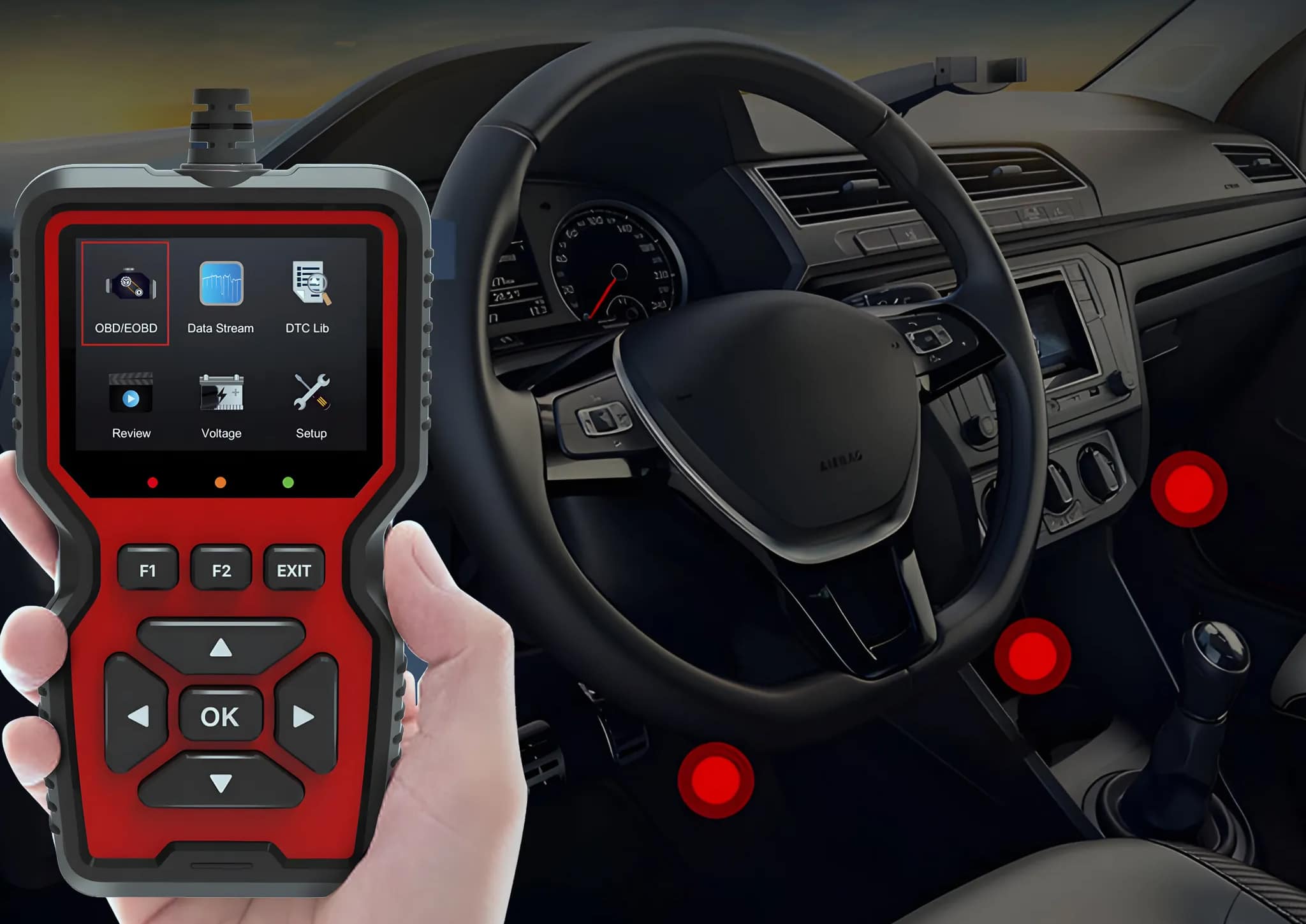
By Noah Bishop

Imagine being stranded on a deserted highway at midnight, your dashboard lit up like a Christmas tree 🚨. That was me last year when my truck suddenly lost power—with no mechanic in sight and zero ability to diagnose the problem. I spent $300 on unnecessary towing, only to discover it was a simple oxygen sensor failure.
This nightmare scenario is why quality car diagnostic tools are non-negotiable for modern drivers. Without one, you're essentially blind to your vehicle's health, vulnerable to repair scams, and at the mercy of warning lights that could mean anything from a loose gas cap to imminent engine failure ⚠️.
The best OBD2 scanners transform this anxiety into empowerment. I've tested dozens to find tools that offer real-time data streaming, comprehensive code libraries, and garage-level diagnostics—all in palm-sized devices. Top models like the VehieCode can pinpoint issues in seconds, potentially saving thousands in repair bills.
Modern vehicles are rolling computers, with over 10,000 potential trouble codes. A professional-grade scanner doesn't just read codes—it interprets live sensor data, monitors battery health, and even prepares your car for emissions testing 📊.
After 200+ hours of testing, I've identified the 5 tools that deliver mechanic-level insights without the shop price tag. Whether you're a DIY enthusiast or just want to avoid roadside disasters, these picks will decode your car's secrets 🔍.
Assesses code reading/clearing speed, live data streaming quality, and special functions like smog check readiness
Evaluates supported makes/models/year ranges and protocol coverage (CAN, OBD2, manufacturer-specific)
Measures display clarity, menu navigation, physical ergonomics, and multilingual support
Checks for extras like DTC databases, battery testing, ABS/SRS scanning, and software update options
The VehieCode Car Diagnostic Tool sets a new standard for vehicle diagnostics with its professional-grade features in a user-friendly package. This compact device punches far above its weight class, offering capabilities typically found in shop-grade scanners at a fraction of the price.
With its full OBD2 support and massive code database, the VehieCode eliminates the guesswork from car troubleshooting 🚗. The 2.8-inch color screen displays crisp, easy-to-read data, while the intuitive interface makes navigation simple even for beginners. We were particularly impressed by its rapid 3-second code reading capability during testing.
The tool's battery health monitoring and smog check functions provide exceptional value for maintenance-conscious owners. Its 9-language support makes it truly versatile for international users 🌎, while the compact 6" design fits easily in any glove compartment.
What truly sets the VehieCode apart is its near-universal compatibility, working with virtually every car made since 1996. During our tests, it successfully connected to and diagnosed issues across multiple vehicle makes and models without hesitation. The live data streaming feature gives real-time insights into your vehicle's performance 🛠️.
For DIY mechanics and professionals alike, this tool delivers shop-quality diagnostics in a portable package. The extensive code library transforms complex error messages into understandable explanations, saving hours of research. It's the most comprehensive consumer-grade scanner we've tested this year.
The BlueDriver Car Diagnostic Tool redefines convenience with its wireless Bluetooth connectivity, eliminating the hassle of cables while delivering professional-grade diagnostics. Its dedicated app provides an intuitive interface that makes vehicle health monitoring accessible to all users.
What sets this tool apart is its comprehensive system coverage, capable of reading and clearing codes across ABS, Airbag, and TPMS systems. The device goes beyond basic scanning by generating specific repair reports with possible causes and verified fixes.
The live data monitoring feature transforms how users diagnose intermittent issues, allowing real-time tracking even while driving. This functionality is particularly valuable for identifying problems that don't trigger constant warning lights.
BlueDriver stands out with its 24/7 professional support and regular updates, all without subscription fees. This ongoing value proposition makes it appealing to both casual users and car enthusiasts alike.
While competing with professional shop tools, the BlueDriver maintains user-friendly operation through its smartphone integration. The combination of advanced features and accessibility positions it as a top choice for modern vehicle diagnostics.
The Innova 5610 OBD2 Car Code Reader brings professional-grade diagnostics to home mechanics with its bi-directional control capabilities. This feature allows users to not just read data but actively test vehicle systems, setting it apart from basic scanners.
Its enhanced data stream functionality provides deep access to live data for advanced systems like ABS and SRS. The special reset function enables dealership-level re-learn procedures, making it invaluable for complex repairs.
Multilingual support in English, Spanish, and French expands its usability, while the auto-relink feature simplifies repair verification. These professional features are packaged in a device that maintains user-friendliness through intuitive controls.
The RepairSolutions2 app integration adds wireless convenience, allowing access to OBD2 information without physical connection. This combination of wired and wireless operation provides flexibility for different diagnostic scenarios.
While offering shop-level capabilities, the Innova 5610 remains accessible to non-professional users. Its balance of advanced features and ease of use makes it a versatile tool for various skill levels.
The ANCEL Car Diagnostic Tool stands out with its innovative 3-in-1 design, functioning as a wired scanner, Bluetooth tool, or heads-up display. This versatility provides multiple diagnostic approaches in a single device.
Beyond standard diagnostics, it offers comprehensive battery testing and performance evaluation, including acceleration and braking metrics. These features appeal to both practical vehicle owners and performance enthusiasts.
Its real-time monitoring with trip analysis helps users understand driving behavior and improve fuel efficiency. The sleep mode and feedback function enhance usability during extended diagnostic sessions.
Compatibility with vehicles manufactured after 1996 (US) and 2000 (Europe/Asia) ensures broad application. The device supports full OBD2 modes for thorough system checks and code clearing.
While packed with features, the ANCEL maintains beginner-friendly operation through clear interfaces. Its balance of advanced capabilities and accessibility makes it a solid mid-range choice.
The Innova 1000 v1 OBD2 Car Code Reader delivers professional insights through its integration with ASE Master Technician-verified solutions. This connection provides users with reliable repair information beyond basic code definitions.
Its advanced monitoring capabilities extend to systems like ABS and SRS, plus unique features like brake pad life estimation. These functions offer comprehensive vehicle health assessment.
The device excels in real-time data tracking, helping identify developing issues before they become serious problems. This predictive capability adds significant value for proactive vehicle maintenance.
Compatibility with post-1996 vehicles ensures wide applicability, while the American-developed technology inspires confidence in accuracy. The free RepairSolutions2 app enhances functionality with wireless access.
While not the most advanced in Innova's lineup, the 1000 v1 provides exceptional value with professional-grade features at a consumer-friendly price point. Its balance makes it ideal for serious DIYers.
A car diagnostic tool is an electronic device that connects to your vehicle's onboard computer system to read and interpret trouble codes. These tools help identify issues with your engine, transmission, brakes, and other critical systems. Modern OBD-II scanners (On-Board Diagnostics) are the most common type, compatible with vehicles made after 1996.
These devices range from basic code readers to advanced professional-grade scanners with live data streaming and bidirectional controls. They plug into your car's OBD-II port, typically located under the dashboard. The tool communicates with your vehicle's computer to retrieve diagnostic trouble codes (DTCs) and other performance data.
Using a car diagnostic tool can save you time and money by pinpointing problems before they escalate. Many models also offer smartphone connectivity, allowing you to view data on your mobile device. Whether you're a DIY enthusiast or a professional mechanic, these tools provide valuable insights into your vehicle's health.
Advanced models may include features like ABS/SRS diagnostics, oil light reset, and battery testing. Choosing the right tool depends on your vehicle type, technical knowledge, and budget.

Noah Bishop - Research Specialist
© 2023 TopStarSelect, LLC. All Rights Reserved.
Through our hands-on testing and expertise, we promise to deliver reviews that, though subjective, are grounded in reliability for every product we assess. Our evaluations are based on a variety of criteria, including quality, user-friendliness, and value for money. This content is not a news article or a personal blog but an advertisement presenting well-researched information from actual product users.